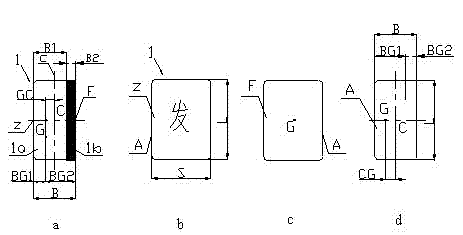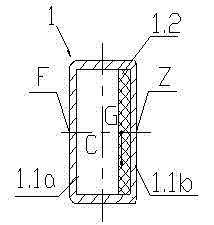Mahjong tiles
A technology of mahjong tiles and losing tiles, applied in sports accessories, indoor games, etc., can solve the problems that the accuracy cannot meet the requirements, and the non-magnetic mahjong machine products are not put in batches, etc., to achieve accurate tiles and reliability of flop actions , the effect of simple structure
- Summary
- Abstract
- Description
- Claims
- Application Information
AI Technical Summary
Problems solved by technology
Method used
Image
Examples
Embodiment 1
[0039] Please refer to figure 1 , The mahjong tiles are connected by two materials with different densities. among them figure 1 a and 1d are the side lying state of the card, figure 1 b and figure 1 c are figure 1 The left and right views of the mahjong card shown in a respectively show the front Z and the back F of the card. The length of the card is L, the width is S, and the thickness is B. The above two materials with different densities can be made of plastic materials with a lower density and plastic materials with a higher density (or a higher density material added to the plastic material). One side of the same is the same as the front or back of the card but the thickness is the same. Different rectangular block 1a and rectangular block 1b, the thickness of the rectangular blocks 1a and 1b are B1 and B2 respectively, and the sum of the two is exactly the thickness B of the mahjong tile. The card forms a side lying surface with its length L and thickness B lying on the...
Embodiment 2
[0042] See figure 2 , The mahjong tiles are also made of two different density materials. Made of a relatively low-density material, such as ordinary plastic, a rectangular cavity shaped like a card. The rectangular cavity is composed of a box 1.1b containing the front face Z of the card and a box cover 1.1a containing the back face F of the card. Materials such as high-density stone or iron are made of rectangular block 1.2. The rectangular block 1.2 fits into the cavity and is placed in the cavity corresponding to the front Z end of the card box body, connected to the inner bottom surface of the bottom end, close to One end of the Z on the front of the card. The box cover 1.1a is sealed on the opening end of the box body 1.1b by molding or other general technical means to form a mahjong tile 1. The card's center of gravity is biased to the front Z and to the side of the card's geometric center C. According to the above embodiment 1, the card also has a center of gravity th...
Embodiment 3
[0045] See image 3 , The mahjong tiles are made of one material. A cavity is provided on the inner side along the thickness direction of the card, for example, a cavity is provided on the inner side near the end of the reverse side F of the card, so that the density of the end near the reverse side of the card is less than the density of the end near the front side of the card. Make the density distribution of the cards different in the thickness direction. The specific structure can also be made into the structure of the box body 1.1b and the box cover 1.1a mentioned above, but the thickness H1 of the bottom end of the box body near the front end of the card is much larger than the thickness H2 of the bottom end of the box near the back end of the card, so that The center of gravity G is on the front side of the card. Of course, you can also shift the center of gravity to the back end of the card as needed, which is easy for those skilled in the art. Also according to the a...
PUM
 Login to View More
Login to View More Abstract
Description
Claims
Application Information
 Login to View More
Login to View More - R&D
- Intellectual Property
- Life Sciences
- Materials
- Tech Scout
- Unparalleled Data Quality
- Higher Quality Content
- 60% Fewer Hallucinations
Browse by: Latest US Patents, China's latest patents, Technical Efficacy Thesaurus, Application Domain, Technology Topic, Popular Technical Reports.
© 2025 PatSnap. All rights reserved.Legal|Privacy policy|Modern Slavery Act Transparency Statement|Sitemap|About US| Contact US: help@patsnap.com



